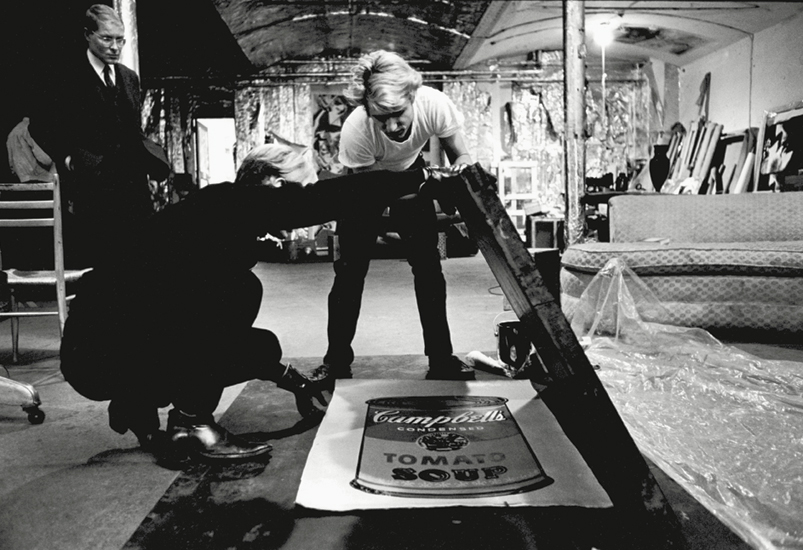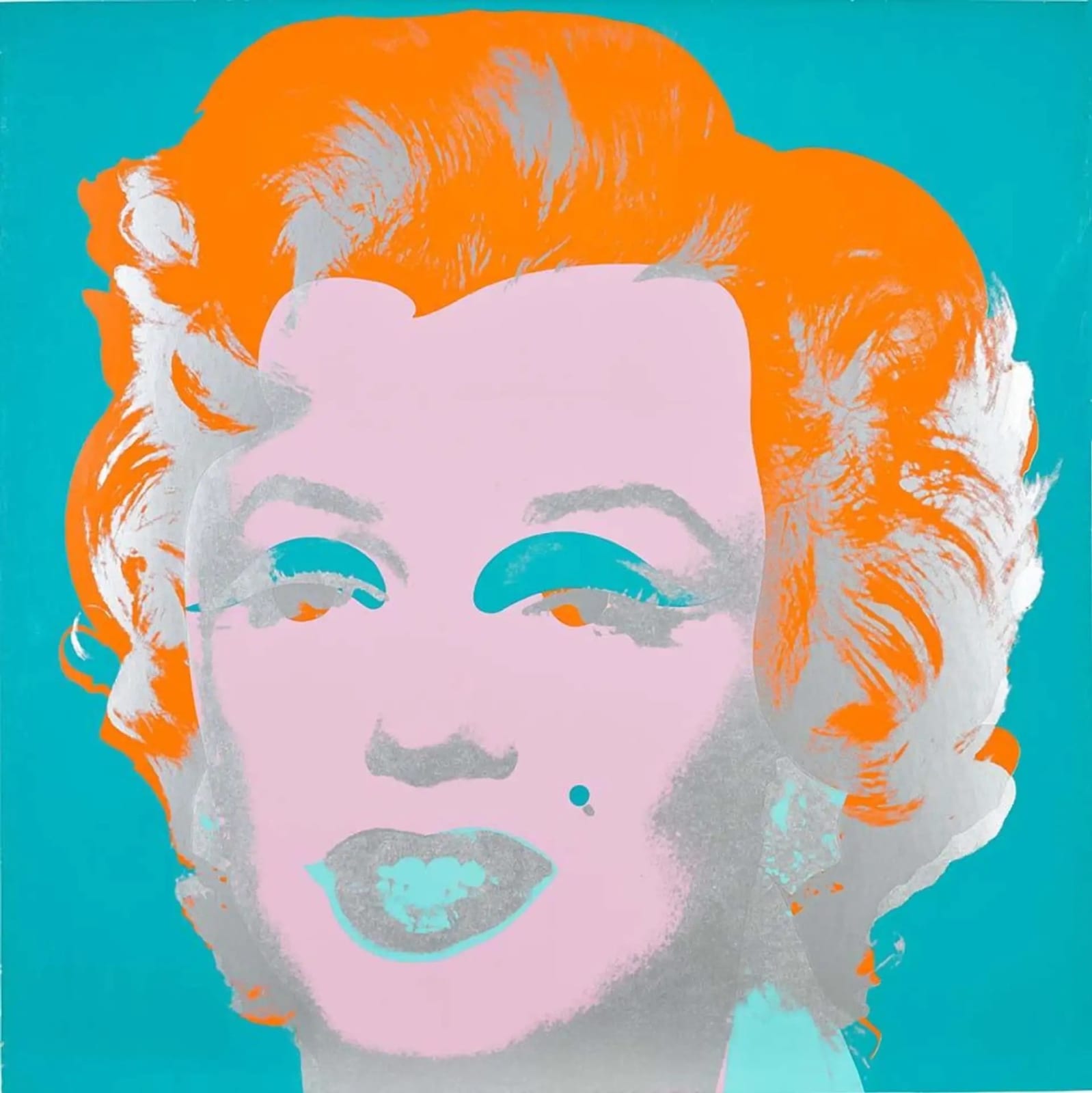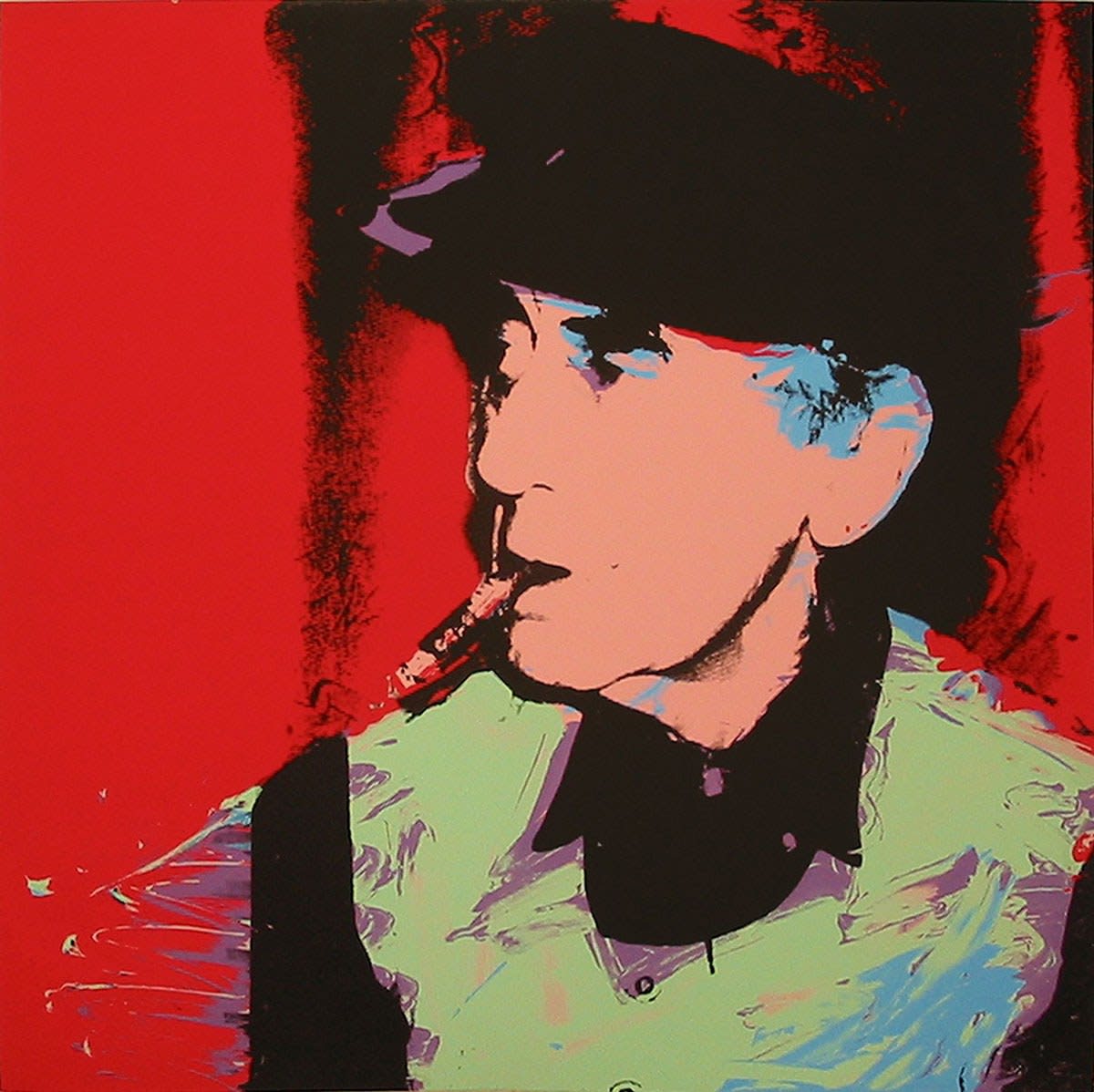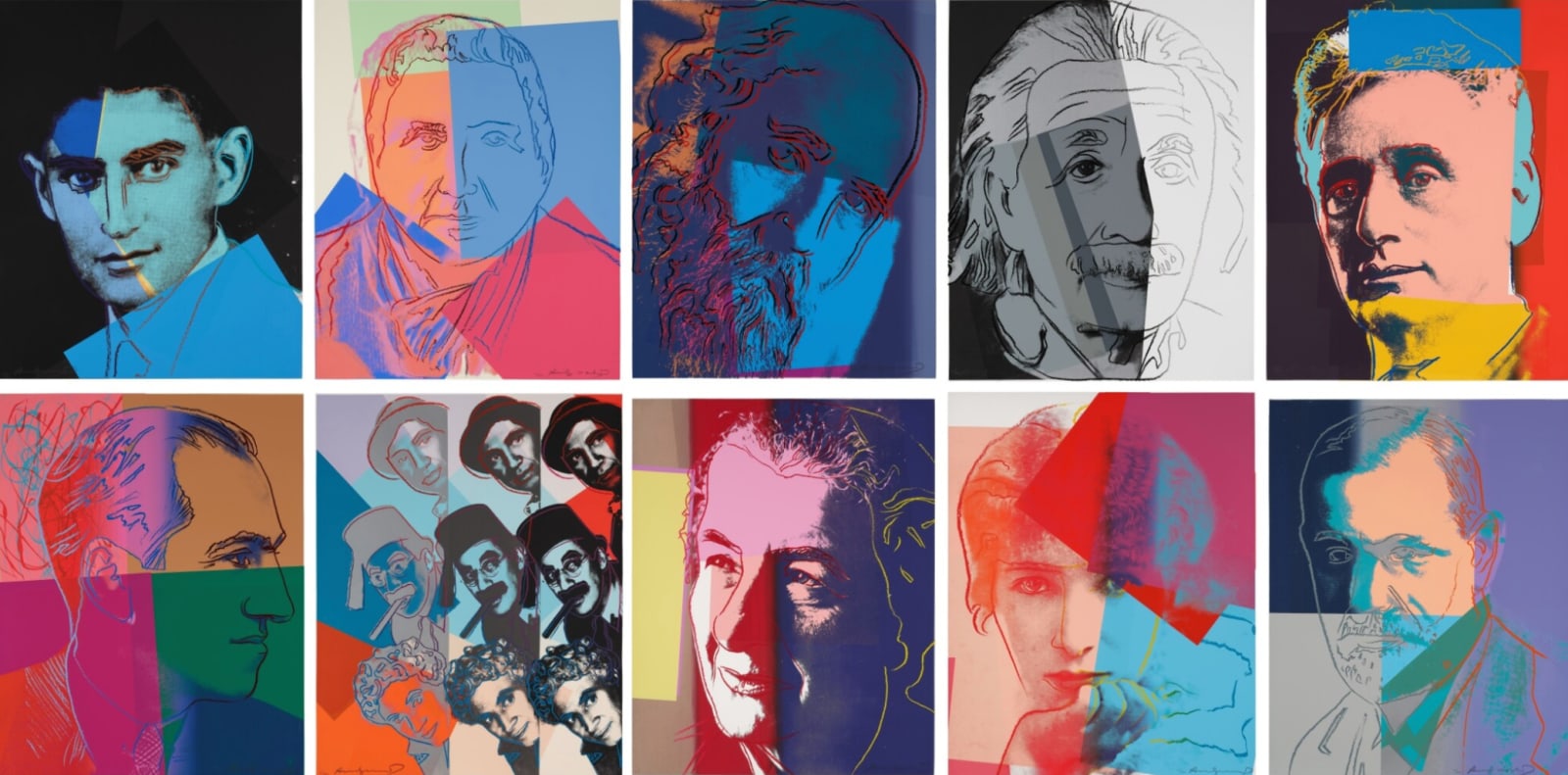“The reason I’m painting this way is that I want to be a machine.”— Andy Warhol, 1962
Andy Warhol’s name is practically synonymous with Pop Art, fame, and the art of the portrait. From Campbell’s Soup cans to Brillo Boxes to endlessly repeated images of Marilyn Monroe, Warhol created many of the 20th century’s most iconic artworks. A leading figure of the Pop Art movement, he was fascinated by celebrity and consumer culture. Throughout his career, Warhol worked across painting, film, and photography, but he is especially renowned for his vibrant screen-printed portraits, which revolutionized modern art’s approach to image-making. Warhol turned photographs of both the famous and the ordinary into bold silkscreen prints, reflecting his obsession with fame while probing deeper questions of identity, legacy, and mortality.
The Art of Screen‑Printing
In 1962, Warhol embraced photographic silkscreen printing as his signature technique. Drawn to its mechanical, repetitive nature, he found that screen-printing allowed him to reproduce the imagery of mass media and popular culture with ease. Warhol did not invent the process, but he made it his own by combining black-and-white photographic images with brilliantly colored, hand-painted backgrounds and accents. This marriage of mechanical reproduction and personal touch gave his prints a distinctive style. Ironically, although he professed a desire to be “machine-like” in his art, Warhol’s silkscreen portraits are so unique that they are instantly recognizable as “Warhols.”
Working out of his New York studio (famously known as The Factory), Warhol applied the silkscreen process to a wide array of subjects. He screen-printed commissioned portraits of wealthy patrons from Polaroid photos, and he also appropriated images of public figures from newspapers and magazines to make fine art. The result was a body of work that turned faces into icons. From Hollywood starlets and rock musicians to world leaders – and even Warhol’s own self-portraits – his screen-printing practice blurred the line between commercial reproduction and high art. In the following sections, we explore Warhol’s most significant screen-printed portraits and what they reveal about art and fame. Read more about what techniques warhol used.

Warhol’s Celebrities
Andy Warhol had an enduring fascination with celebrity culture, so it’s no surprise that he produced dozens of portraits of the stars of his era. In the early 1960s, living and working in New York, Warhol began creating portraits of famous figures drawn from publicity photos and tabloid shots. He was captivated by the idea of serial repetition – printing the same face multiple times with different color palettes or in grids. This repetitive seriality became one of Warhol’s key artistic strategies. By showing a celebrity image over and over, Warhol elevated a film still or newsphoto into a kind of modern religious icon, while also commenting on how fame turns people into mass-produced products.
Warhol’s Marilyn Monroe prints are perhaps his most famous use of repetition and color variation. Monroe was actually the first subject of his silkscreen portraits. Shortly after the actress’s untimely death in August 1962, Warhol began reproducing a 1953 publicity photo of her (from the film Niagara). He created multiple works featuring Marilyn’s face, the most celebrated being Marilyn Diptych (1962), which consists of 50 images of Monroe split across two canvases. One canvas bursts with bright, candy-colored versions of her face; the other is printed in stark black-and-white, the image fading. Side by side, the two panels have often been seen as representing Marilyn’s dual existence: the vibrant, immortal public persona on one hand, and on the other the shadowy, fragile private self haunted by tragedy. Marilyn Diptych has become an icon of Pop Art in its own right, epitomizing Warhol’s ability to capture the glamour and the darkness underlying celebrity.
Throughout the 1960s and into the 1970s, Warhol continued to churn out celebrity portraits that today define Pop Art imagery. He portrayed stars like Elvis Presley, Elizabeth Taylor (Liz Taylor), Jackie Kennedy, and later Judy Garland, Mick Jagger, Debbie Harry, and Dolly Parton, among many others. In each case, Warhol would experiment with bold hues – electric pinks, acidic oranges, vivid blues – imbuing the familiar faces with a new psychedelic energy. He also often presented them in series or multiples, reinforcing the sense that these personalities were being mass-reproduced.
Yet behind the candy-colored surfaces, Warhol acknowledged a darker side to this repetition. By mechanically reproducing a star’s likeness over and over, he hinted at an emotional detachment in how we consume famous faces. The endless copies suggest that in a mass-media age, even a person’s identity can be flattened into an image and drained of uniqueness. Warhol once quipped, “Isn’t life a series of images that change as they repeat themselves?” This idea is central to his celebrity portraits. The likes of Elvis or Marilyn are shown as endlessly reproducible – shining and glamorous, yet also eerily two-dimensional. Decades later, these portraits are still instantly recognizable and have themselves become enduring symbols of popular culture.

Commissioned Portraits
By the mid-1960s, Warhol had begun to accept portrait commissions, effectively turning portraiture into a thriving business and art form of its own. In 1963 he painted his first commissioned society portrait, Ethel Scull 36 Times. Ethel Scull, a New York socialite and art collector, sat for Warhol in a Times Square photo booth, resulting in a grid of 36 candid images which Warhol transferred to canvas. This portrait (a collaboration in concept with photographer Billy Name) is considered a landmark, signaling Warhol’s foray into commissioned portraiture of the rich and famous. From that point on, Warhol rarely turned down a commission – if you could pay, you could be painted by Warhol. He democratized the portrait-for-hire, bringing the glitzy aura of Pop Art to anyone who could afford his fee.
Warhol’s commissioned portrait enterprise truly took off in the 1970s. In 1979, the Whitney Museum of American Art exhibited “Andy Warhol: Portraits of the 70s,” a show that featured many of his commissioned works and elevated the status of these portraits in the art world. By the early 1980s, Warhol was reportedly painting around 50 commissioned portraits a year. He charged roughly $25,000 per portrait (and about $40,000 for a larger double-canvas portrait), making this side of his art extremely lucrative. The income from society portrait commissions helped fund Warhol’s more experimental projects and the day-to-day operations of The Factory studio. In essence, Warhol had turned himself into a portrait machine for high society – an idea he fully embraced as part of his artistic identity. (It was Warhol, after all, who famously said, “In the future, everyone will be famous for 15 minutes,” reflecting his ironic take on the fleeting fame his clients craved.)
Despite the commercial nature of these commissions, Warhol approached their creation with his characteristic method and flair. He favored using a Polaroid camera to photograph his subjects in a tightly controlled, often flash-lit style. Warhol playfully called the Polaroid his “pencil and paper,” treating the instant photos as the first step in his artistic process. He would then enlarge the chosen Polaroid images and convert them into high-contrast negatives, which could be burned onto silkscreen meshes. From these, Warhol screen-printed the sitter’s face onto canvas, usually in bold outline, and finally embellished the portraits with vivid blocks of hand-mixed color. The result was a striking, larger-than-life likeness with flat, pop colors – a unique blend of flattery and Warholian edge.
This photographic process was crucial to Warhol’s philosophy. He recognized the power of photography in shaping public image and satisfying the public’s obsession with celebrity. By filtering his painted portraits through the mechanical eye of a camera, Warhol added a layer of mediation between the subject and the viewer. The Polaroid’s instant, slightly raw quality imparted a truthfulness (every wrinkle or shadow was captured), yet the silkscreen and paint overlay added Warhol’s signature gloss, reminding us that appearance is a construct. It’s no coincidence that Warhol loved the ephemeral nature of Polaroid snapshots and the idea that a momentary image could become immortal art; this perfectly echoed his musings on the transient nature of fame and beauty.
Warhol’s openness to commissions extended beyond human subjects. An animal lover himself, he even painted portraits of people’s pets on request. Throughout his career, he completed a number of commissioned pet portraits – for example, a 1976 silkscreen painting of a dachshund named Maurice. In Warhol’s hands, even a beloved dog could receive the Pop Art treatment, elevated to the same level of glamour as a movie star. These society portraits – whether of tycoons, trophy wives, or their pets – reinforced Warhol’s self-image as an art machine and satirized the very idea of portraiture as a commodity in the age of celebrity.
Fellow Artists and Trailblazers
Not all of Warhol’s portraits were done for paying clients or Hollywood stars. As his career progressed into the 1970s and ’80s, Warhol increasingly created portraits of people he personally admired – often fellow artists or cultural trailblazers who intrigued him. For instance, Warhol looked up to the great Dada artist Man Ray, a pioneer of photography and conceptual art. In 1973, Warhol met the 83-year-old Man Ray and took a Polaroid photograph of him. From that image, Warhol made a silkscreen portrait (completed in 1974) that honors Man Ray in Warhol’s bold style – a meeting of two art world legends across generations. Similarly, Warhol painted portraits of contemporary artist friends such as the young superstar Jean-Michel Basquiat (with whom Warhol would also collaborate on joint paintings) and fashion designer Yves Saint-Laurent. These works were born from genuine admiration and friendship rather than commerce, showing Warhol’s desire to celebrate figures he found inspiring or culturally important.
Warhol’s interest in famous faces also led him to depict political icons, blurring the line between celebrity and notoriety. One of Warhol’s most widely recognized portrait subjects is Mao Zedong, the Chairman of the Communist Party of China. The idea to portray Mao came from Warhol’s astute art dealer, Bruno Bischofberger, who suggested in 1972 that Warhol paint the most famous person in the world. After reading a Life magazine article that described Mao as the world’s most famous figure, Warhol eagerly agreed. That same year, as President Nixon made historic visits to China, Warhol began his Mao series. Between 1972 and 1973, he created 199 paintings of Mao in wildly flamboyant color combinations. In these works, Mao’s stern official photograph (from his Little Red Book) is cloaked in patches of pink, slashes of lipstick red, turquoise shadows, and other incongruous hues. By doing so, Warhol drew a provocative parallel between political propaganda and commercial advertising – suggesting that Mao’s proliferating image in China was akin to a Coca-Cola logo or a Marilyn Monroe publicity shot in the West. The Mao series was controversial yet acclaimed, and it reasserted Warhol’s perennial theme: the cult of fame applies as much to dictators and politicians as it does to movie stars.
In the mid-1980s, Warhol turned his silkscreen technique toward another 20th-century revolutionary figure: Vladimir Lenin. In a series of portraits of Lenin, Warhol used a dramatic red and black palette, further exploring the intersection of fame, power, and myth-making. These Lenin paintings, completed around 1986, would become the last major portrait series Warhol worked on before his unexpected death in 1987. By tackling Lenin – a symbol of political revolution – Warhol came full circle in examining how images shape the legacy of powerful individuals. Whether depicting avant-garde artists or notorious world leaders, Warhol treated each of their images with the same Pop Art sensibility, underlining how modern culture turns people into symbols and blurs the boundaries between celebrity, art, and politics.

Portrait Series and Themed Works
In addition to standalone portraits, Warhol often developed entire series of portraits centered on a common theme or group. These series, many of which were also commissions or gallery projects, allowed Warhol to explore fame across different spheres of society. Notable examples include:
-
Athletes (1977–1979): A series commissioned by art collector Richard Weisman, featuring ten famous sports stars of the day. Warhol created vivid portraits of athletes like Muhammad Ali, Pelé, Dorothy Hamill, and O.J. Simpson, among others, highlighting sports heroes as a new kind of celebrity in pop culture. Each athlete’s portrait was brightly colored and boldly cropped, placing them on the same pop pedestal as Warhol’s Hollywood stars. (Andy Warhol Portraits: A Definitive Guide) (Andy Warhol Portraits: A Definitive Guide)
-
Ten Portraits of Jews of the Twentieth Century (1980): A portfolio that Warhol produced featuring ten prominent Jewish figures from history, including the likes of Albert Einstein, Franz Kafka, Golda Meir, and Sarah Bernhardt. Using source photographs, Warhol silkscreened each figure’s face with overlays of pastel hues and abstract blocks of color. This series courted some controversy and discussion about identity and commercialism, but it was in keeping with Warhol’s interest in famous faces – in this case, a mix of cultural icons and historical greats.
-
Reigning Queens (1985): A glamorous series portraying four ruling female monarchs of the mid-1980s: Queen Elizabeth II (United Kingdom), Queen Beatrix (Netherlands), Queen Margrethe II (Denmark), and Queen Ntombi Twala of Swaziland (now Eswatini). Warhol sourced official photographs of each queen and rendered them in regal yet poppy colors (vivid purples, oranges, pinks), sometimes adding glittering diamond dust to the prints. By immortalizing contemporary queens in his Pop Art style, Warhol wittily linked the pomp of old-world royalty with the visual language of modern celebrity.
All of these series underscore Warhol’s central fascination: fame, status, and image. Whether the subject was an athlete, a religious figure, or a royal, Warhol approached them as icons to be flattened, repeated, and re-colored, turning history and current events alike into lively Pop Art. Each portfolio was also presented as a set of multiples (often in editions), blurring fine art with a commercial, print-shop sensibility.
One of Warhol’s most poignant portrait series is Ladies and Gentlemen (1975), which marked a significant departure in subject matter. Rather than famous household names, this series focused on the drag queens and transgender women of New York’s underground drag scene. In 1974, Italian art dealer Luciano Anselmino commissioned Warhol to create a series of 105 portraits of drag queens, sensing it could be both commercially and artistically interesting. Warhol, whose social circle had long included LGBTQ individuals and who had featured drag performers in earlier films, embraced the project with enthusiasm. He sought out models from clubs in downtown Manhattan (with the help of friends) and ultimately photographed 14 different drag performers using his Polaroid camera. In characteristic fashion, Warhol overshot the commission – he took over 500 Polaroid shots and produced over 200 paintings, far exceeding the original 105 portraits requested. The resulting works, collectively titled Ladies and Gentlemen, range in size and composition, but all celebrate the vibrant personas of the models. Warhol applied wild color combinations to the silkscreened faces – turquoise eyeshadow, neon yellow background, deep pink lips – amplifying the glamour and drama that these drag artists embodied on stage.
This series was created in the wake of the Stonewall riots (1969) and the growing gay rights movement, as well as the personal loss of Warhol’s friend and Factory superstar Candy Darling (a transgender actress who died in 1974). Ladies and Gentlemen can be seen as Warhol’s tribute to a marginalized community that was often overlooked or stigmatized. By placing these drag queens on canvases with the same Pop Art treatment he gave to Liz Taylor or Jackie O, Warhol effectively asked the viewer to recognize their beauty and cultural significance. One of the most featured models in the series was Wilhelmina Ross, a downtown drag performer. Ross appears in 73 of the portraits, her face rendered over and over in different color schemes. In each, she exudes a proud, stylish presence – sometimes laughing, sometimes pensive – capturing the charisma that drew Warhol to his subjects. Through Ladies and Gentlemen, Warhol not only created stunning images (now prized by collectors and museums) but also broke ground by spotlighting drag culture in fine art. The series stands as a powerful example of Warhol’s willingness to embrace marginalized subcultures and challenge viewers’ perceptions of gender and identity, all within the ostensibly glamorous format of portraiture.

Self-Portraits
Andy Warhol’s most enduring subject might have been Andy Warhol himself. Throughout his life, the artist repeatedly turned the camera and canvas toward his own image, producing self-portraits that are now as famous as the celebrity portraits he made of others. From his early black-and-white photo booth self-portraits in 1963 (in which Warhol used a strip of four snapshots from an automated photo machine) to his haunting Self-Portrait with a “Fright Wig” in 1986 (showing Warhol in a disheveled platinum wig, staring pale-faced against a dark background), Warhol charted his changing persona over the decades. In fact, the 1986 Fright Wig series was created just a few months before his unexpected death in February 1987, adding a poignant coda to his lifelong project of self-imaging.
Self-portraiture is a classic art historical genre, and Warhol made it a cornerstone of his oeuvre. Keenly aware of the power of image, Warhol treated his own appearance as another artistic medium to experiment with. He was conscious of the superficial nature of fame and how identity could be manufactured. Ever the self-promoter, Warhol carefully cultivated a public image – the gaunt face with big round sunglasses, the eccentric silver-blond wigs, the enigmatic half-smile. In many self-portraits, he almost disguised himself as “Andy Warhol.” For example, he would sometimes wear different wigs or even dress in drag (as in a 1981 series of Polaroids where he appears in full makeup and women’s clothing) to explore how changing his look altered the persona he projected. By emphasizing certain features – the wig’s wild hair, or exaggerating the contrast in his facial features – Warhol effectively caricatured himself, turning his own identity into a pop icon not unlike his Marilyn or Mao.
The tone of Warhol’s self-portraits varies dramatically, oscillating between superficial flash and deep introspection. Some images present him as the cool, detached Pop Art celebrity he had become – confident, stylish, and blank, as if he himself were a silkscreened product. Others reveal hints of vulnerability and mortality. In the Self-Portrait with Fright Wig, for instance, his head appears disembodied, floating in darkness, eyes hollowed out by shadow; it’s often interpreted as a memento mori, a confrontation with his own fear of death. Over the years, Warhol’s self-portraits collectively toy with the viewer’s perception: Are we seeing the real Andy, or just another constructed image? In truth, it’s a bit of both. Warhol once remarked that he wanted to “disappear” into his art, and through these self-portraits he simultaneously hides behind a carefully crafted façade and bares his preoccupations (fame, appearance, mortality) for all to see.
In the end, Andy Warhol’s portraiture—whether depicting Hollywood legends, socialites, artists, drag queens, athletes, or himself—fundamentally changed the way we think about portraits in art. He showed that a portrait could be more than a likeness; it could be a commentary on society’s images, a reflection of our collective desires and fears, and a statement on the nature of fame itself. Warhol’s portraits turned the faces of his era into indelible works of art, and in doing so, he secured his own image as one of the most influential artists in modern history.
Explore our Andy Warhol Prints for sale or to buy Andy Warhol paintings, contact info@guyhepner.com for more information. Looking to sell? We can help, find out how to sell Andy Warhol prints at Guy Hepner.

